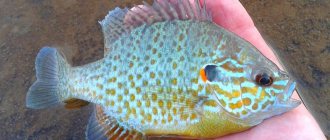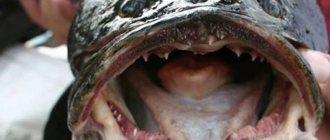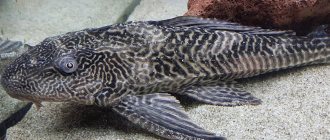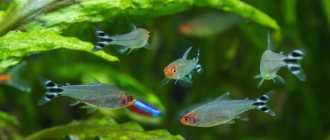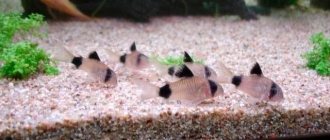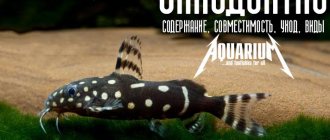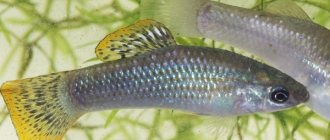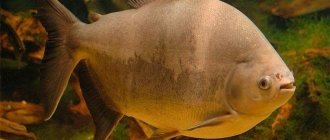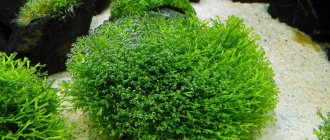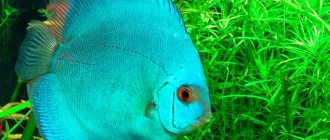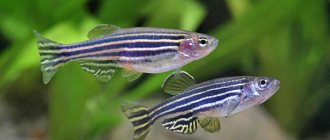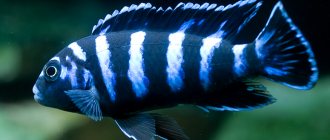They first appeared in Europe, where in 1877. Soon the sunfish began to breed in ponds, and once in the Danube, they settled in the lower reaches of rivers flowing into the northwestern part of the Black Sea region. The sun perch's excellent adaptability to changing living conditions has allowed them to become quite widespread throughout the waters of Europe.
The sun perch reaches a length of 15 to 30 cm. The male is brighter in color and has a black spot with a red border on the gill cover. In the female, the edging is usually absent or weakly expressed.
Sun perch continue to spread today. This is also facilitated by the fact that the fish reaches sexual maturity by the age of one year. Males actively guard a clutch of more than three hundred eggs.
Habitat
Currently, this fish of the perch family is found even on the middle reaches of the Dnieper. Almost all rivers and even reservoirs in Ukraine are rich in it. It easily tolerates significant increases and decreases in water temperature and can easily overwinter in a pond covered with ice.
American sunfish can be caught in Ukraine all year round. But it bites especially well in sunny weather. Apparently, this is how it got its original name. Living in rivers or lakes, sunfish always stay close to the shore. Accordingly, it is easier to detect it there than in the middle of the river. Preferring shallow depths - up to a maximum of two meters, sun perch moves in small schools, keeping the direction either along the cut of the grass or along the coastal edge. The fish seems to be patrolling its territory. In such a place, sunfish are caught easily and quickly. And some flocks, even occupying a certain area, do not leave it for a long time. Most often this is a place under bushes or overhanging trees, as well as a clearing in algae or reeds.
Eared
The eared perch is native to the USA. It is also found in reservoirs of Western Europe that flow into the Black Sea. Under natural conditions, the length of the body is about 23 cm, and when grown in an aquarium it grows up to 14 cm. The characteristics of this animal are as follows:
- the body is tall, stocky, strongly flattened at the sides;
- the gill covers have processes colored orange-red;
- body color – gray-green and brown-yellow;
- there are silvery transverse stripes and scarlet spots;
- in adults, the color is brownish, there are shiny green stripes along the body;
- fins are colored green or yellow;
- rear fin dark;
- The females are smaller in size than the males, their color is not so bright, the skin process without an edge.
These fish are peaceful. They can show territoriality only with the onset of the spawning period. Several individuals are raised in an aquarium in Russia; they get along well together. To ensure comfortable living conditions, it is recommended to equip the aquarium with shelters and vegetation. You also need to provide aeration, filtration, and change the water several times a week. Good lighting is needed; bloodworms, daphnia or plant substitutes are used as food.
Such aquatic inhabitants tolerate high water temperatures well in summer; during hot periods they live in the upper layers of water. They do not swim very actively; they prefer to stay in one place with their fins fluffed up. With the onset of winter, they sink to the bottom of the reservoir and do not need much oxygen. The spawning period begins in the second decade of May and lasts until the end of July. During this period, the female is able to lay up to 30 thousand eggs. The male builds the nest. After fertilization of the eggs, the males protect and protect the future offspring, thanks to their fins they ensure water circulation for better aeration.
The larvae begin to hatch within a day. The basis of their diet are daphnia, cyclops and ciliates. After a while, as they grow, they begin to feed on insect larvae, small fish, and crustaceans.
Yandex.Pictures
Fishing
Despite its small mouth, this greedy fish swallows even the fry of other inhabitants of the reservoir. Based on this, experienced fishermen use large hooks of a fairly large number - tenth - when catching American perch. The best treat for this fish is maggot , although when fly fishing with dry flies it swallows the hook almost completely. It must be said that some consider the sunfish to be a “trash” fish, which, quickly multiplying, begins to destroy the eggs of more valuable commercial species, thereby causing harm
Keeping in an aquarium
There is every reason to believe that the sunfish is an invasive fish species. Thanks to its insatiable appetite, the “American” is currently a real threat to European fish species. After all, the “sunny guest” fights with the aborigines not only for food, but also destroys their eggs and fry. The rapid reproduction of sunfish causes significant damage to the ecosystems of European rivers and reservoirs, and damages the number of commercial fish species. Due to its small size, the sunfish itself Perch is valued by aquarists and bred as an ornamental fish.
Rules for keeping in an aquarium:
- Fish in captivity are usually smaller than in nature and reach 15 cm in length. Still, for an aquarium, the sunfish is considered a large fish. Considering that the fish are schooling and the recommended number of fish in a school is at least 5 individuals, the required volume of the aquarium is 200–300 liters.
- A weekly water change is required, 30% of the total volume of the aquarium.
- Fish are very sensitive to oxygen starvation. Aeration should take place 14 hours a day.
- Sandy soil is required. Sand plays an important role in spawning.
- The type of plants in the aquarium does not matter. A strong root system is important, because perch can undermine plants.
- Water temperature +16–24 degrees Celsius. In winter, no higher than +20 degrees.
- Any peaceful species of fish, the size of which is at least 15 cm, can become neighbors of the perch.
Nutrition
The fish is voracious and is ready to feed on both live and dry food, and will not refuse herbal supplements. You shouldn't get carried away with dry food. Boiled rice and pearl barley are suitable as a vegetable component. Suitable live food: daphnia, bloodworms, worms (earthworms, dung), fly larvae, fish and shrimp meat, even boiled beef heart.
Tackle
They say that the sun perch has proliferated so much that it can even be caught with a spinning rod. At the same time, he pecks often and greedily. Today it is caught very little, because, due to its small size, it is not a trophy. If the sunny perch does not respond to the spoon, then you need to try to mount the equipment, which is a small jig.
A crawler or earthworm attached to a hook is an attractive delicacy for this inhabitant of reservoirs. Such equipment helps to catch even very passive perch, regardless of where the fishing is carried out - in open water or on ice.
Chemical composition and beneficial properties
Sea bass meat is a good source of nutrients, vitamins and minerals. This is a high-protein, easily digestible product with low calorie content (approximately 110 kcal/100 g).
Fillet is rich in dietary protein and many amino acids, including tryptophan, threonine, isoleucine, leucine, lysine, methionine, cysteine. Nutritionists have calculated that it is enough to eat 200 g of sea bass daily to get all the necessary amino acids.
Sea fish meat contains most of the vitamins important for humans. Vitamins A, (including B12), D, E are contained in sufficient quantities in sea bass fillets. As for micro- and macroelements, they are also presented in doses that are beneficial for the human body. In particular, fish contains calcium, iron, phosphorus, magnesium, potassium, sodium, zinc, copper, manganese, selenium (90% of the daily value).
But perhaps the most well-known component of the chemical composition of sea fish is the omega-3 fatty acid complex. The total composition of omega-3 in 100 g of raw fish is 0.3 g. These substances have a beneficial effect on metabolic processes in the body, they strengthen blood vessels, improve heart function, reduce the concentration of bad cholesterol in the blood, help normalize blood pressure, and also promote weight loss .
The rich chemical composition of the product is the reason why people are advised to consume the meat of this fish for a variety of diseases. Red perch can protect children from rickets, and older people from cardiovascular diseases; this product is good for the nervous and reproductive systems, it increases the body's performance, improves brain function and maintains the beauty of skin, nails and hair.
Iodine-rich sea fish is an indispensable diet product for thyroid disorders. It is very important to include this product in the diet of people with weakened bone tissue (for example, with arthrosis, rickets, after fractures). People with diabetes mellitus feel the benefits of red snapper. As many observations show, regular consumption of sea fish helps maintain glucose levels in the bloodstream within normal limits.
Sea bass dishes are always a good source of antioxidant substances, which are indispensable for creating a strong immune system.
In addition, a menu rich in sea fish is a good choice for expectant mothers, since fillets contain sufficient quantities of substances important for the body of a pregnant woman and the fetus. Nutritional value per 100 g
| Calorie content | 90 kcal |
| Squirrels | 18 g |
| Fats | 1 g |
| Carbohydrates | 0 g |
| Cholesterol | 50 mg |
| Water | 79.08 g |
| Ash | 1.31 g |
| Vitamin A | 15 IU |
| Vitamin B1 | 0.023 mg |
| Vitamin B2 | 0.19 mg |
| Vitamin B3 | 2.4 mg |
| Vitamin B4 | 65 mg |
| Vitamin B5 | 0.33 mg |
| Vitamin B6 | 0.21 mg |
| Vitamin B9 | 9 mcg |
| Vitamin B12 | 1.39 mcg |
| Vitamin D | 151 IU |
| Vitamin E | 0.36 mg |
| Potassium | 386 mg |
| Sodium | 74 mg |
| Calcium | 14 mg |
| Iron | 0.3 mg |
| Magnesium | 27 mg |
| Phosphorus | 205 mg |
| Zinc | 0.36 mg |
| Copper | 0.03 mg |
| Manganese | 0.01 mg |
| Selenium | 63 mcg |
Fishing Features
Many people believe that the best season for catching sunfish is during the spawning season. During this period, the fish are clearly visible in shallow water. But if the moment is missed, and the American bass goes deeper, then determining its location becomes much more difficult. In this case, complementary feeding helps a lot. Those who purposefully go fishing for sunfish, before starting fishing, walk along the shore and throw a little bloodworm into the water. Feeding simply collects a huge amount of potential prey, and bites begin to follow after casting. Fishing with silicone bait is not recommended, since the mouth of the sunfish is very small, and it is difficult for the fish to swallow even inch twisters.
Fishing in winter
When there are sharp bites in winter, the fisherman has to very often put the next bait on the hook. Therefore, for more intensive fishing from ice at such “hot” spots, bait is better suited, which will attract the sun perch with its smell, as well as taste and game. Another prerequisite is that the bait stays well on the hook.
In the middle of winter, the sun perch sometimes takes it so carefully that the angler often does not notice the bite. In some cases, the fish, having taken the bait, rises up with it. Therefore, experienced fishermen must distinguish even the weakest bites in order to make a reliable hook.
It is better to catch perch in a darkened tent or “closely”, shading the hole with something. This makes it possible to clearly see what is happening under the ice layer. And if the water is also clear, then you can even see the fish swallowing the bait. If the bait is at a considerable depth or the reservoir is already cloudy, then, most likely, it will not be possible to observe such a picture. However, if you take a bait with a very bright color, it is possible to notice when it disappears.
When fishing for sunfish from the ice, the float is difficult to follow, so many anglers install a flashlight. If you raise the light source high, the hole will be better visible, regardless of the power, be it a small candle or a very large lantern. And the play of light and shine of the gear will attract fish such as sunfish.
Description of the species
The body of the Californian perch is quite high, slightly flattened on the sides, the average length of an adult is about 30 cm. The tail part is narrow with a short stem. The head of this aquatic inhabitant is large with very large eyes and the same mouth.
A fin stretches along the entire length of the back, its rays form prickly spines. On the edge of the gill covers, growths are formed, which in their shape and appearance resemble ears; as a rule, this is a black crust with a beautiful orange-red edging.
As for coloring, it can vary, it all directly depends on the habitat. But in general, the color of rainbow perch scales can vary from light silver to red-orange. It is the silvery fish that is commonly called moon perch.
In addition, the entire body is covered with a blue patterned mesh, reminiscent of a tiger pattern, which can be clearly seen in dim lighting. There are practically no gender differences, but, as a rule, the male individual is painted in brighter colors; as for the female, she does not have a gill growth, which the male always has.
Color depends on habitat
Perch lifestyle
A predatory perch, it can often be prey to more predatory fish, such as catfish, pike or burbot. In turn, it feeds on any fish, as long as it is suitable in size. And since the perch has a rather huge mouth, the river perch can eat particularly large fish without much difficulty. It also hunts molting crayfish that have lost their shell, eggs, and aquatic insects.
Perch leads a fairly active lifestyle. The fish begin to hunt in the morning. On sunny days, the fish stands in dense underwater vegetation, avoiding the heat and sunlight, and ambushes its prey. Summer days of river perch depend on the lack of food. In winter, perch goes to a depth of up to 50 meters. Rivers and ponds must have a layer of unfrozen water so that fish can swim. Ice holes are necessary to support the life of the perch.
Perch is a particularly voracious fish. If a perch sees a large school of fish, without swallowing the first one, it swallows the second, third, fourth, and so on. Sometimes the perch's stomach becomes completely clogged, and small fish stick out straight from the mouth. It is believed that pike causes enormous damage to perch. But the perch tries not to give in, turning the game over more often. The fish respects cool water and does not consider it acceptable to swim on the surface of the reservoir, but if a fish appears, the perch rises from the depths without hesitation.
Perch spawns in the south of the country in April, and in the north in May; most often the cycle can be delayed and some species can be found even in June.
Hunting for sunfish in winter Video
Sometimes amazing events happen in nature. The appearance of sunfish in the waters of Ukraine is confirmation of this. An inhabitant of the American continent, it somehow incomprehensibly migrated to us, took root, and is now found in abundance in almost all rivers of Ukraine, as well as in some reservoirs.
The sunfish is a member of the perch family. Previously, only river perch was found in our area. But in America there are more perch - striped, largemouth, black, yellow, sun and several other types of perch are found there. But only one of these species has wandered into our region. Why and how is still unknown, but the fact remains a fact.
My first acquaintance with this fish was very unusual. I was fishing on the Seversky Donets River, and a boy of about 13 came up to me. He was catching a roach on a float and a sun perch was caught on his hook. He showed this fish to me and I was stunned - I had never seen anything malicious in the Donets before. The first thought is piranha! I looked at the mouth - there are small teeth... Well, I think that’s it, soon it will be scary to swim. I went online at home and typed a request into Yasha: “Piranha on the Seversky Donets.” And this little monster immediately showed me. I opened it and everything fell into place: it’s just a sunny perch. And I was thinking...
Curiosity passed and the passion of a fisherman awoke in me. It was necessary to catch this little fish at all costs. But how? Our fishermen had absolutely no experience in catching this fish, because few people knew about its habitat in our reservoirs. I started searching foreign sites in order to dig up at least something about this fish. Due to my ignorance of English, I did not learn anything useful. I abandoned the idea of catching a sun perch and simply hoped that one day I would just come across it.
A year after meeting this fish, I was fishing again. I noticed a spinning fisherman on the shore and decided to approach him. Approaching my potential interlocutor, I gasped: he was carrying sunfish one after another! Without hesitation, I asked what and how. He said that exotic fish take a 35 mm twister. I set this up too and started catching small perches! It was great and extremely interesting: I caught more than one sunfish! It turns out that it can be successfully caught with a spinning rod even in our latitudes. This is how he proliferated if he is caught everywhere and bites like our minke whale: greedily and often.
It’s interesting that sunfish don’t bite everywhere. In some places where I have been, people have never heard of the existence of such fish and have never seen it. And in some places, the sun perch is perceived as a trash fish, which normally does not allow catching roach and bream. What conclusion can be drawn from this? Simple: it is completely unclear which parking places this fish prefers. Only one thing is known for sure: the sunny perch stays in the coastal zone, because it warms up best.
Nowadays, sunfish are an interesting trophy that you can target purposefully if you know where they live. Although such a fish cannot be called a trophy, sun perch grows to small sizes. It is difficult to get to the time when this fish is active, and it is generally unrealistic to calculate. Therefore, when setting a goal to catch a sunfish, focus on fishing with passive baits made of edible silicone. This way you will have a better chance of success than using regular rubber.
Sunny perch is a new species and we, spinning anglers, simply have to learn how to catch it. You need to find out its habitat, biting time, identify its favorite baits, etc. As a result, the whole experience will result in a clear picture of understanding this fish. Therefore, if anyone has information about the distribution area of this fish, or has even the slightest experience, unsubscribe on the site by typing in the tags “sunny perch”, or leave comments under this article.
Usually has dimensions from 20 to 40 cm, weight can reach up to 0.6 kg.
- The back is olive in color with a bluish tint.
- The sides have transverse dark stripes and orange spots.
- The head and entire body are covered with a large number of red and green spots.
- The fins are yellow, the tail has a small notch.
- The mouth is small, with bluish lips and small teeth.
The male has small black ears with a red frame. The female's ears are reddish-yellow with a faint edging or without it at all.
How to catch?
There are plenty of ways to catch freshwater perch. It can be caught in spring, summer, autumn – as long as the water is open. Even winter fishing for perch performs well. Several ways to catch river, lake and even sea bass:
- Spinning is a dynamic, effective fishing for any season and reservoir. Used both in shore fishing and from boats. Allows you to conveniently and efficiently catch fast predators using various baits. The most effective rigs are ultralight, retractable leash, etc. However, the gear is somewhat expensive in price. The second disadvantage is that handling the spinning rod is not easy. You should first study the details and practice away from bodies of water.
- Float fishing rod - in comparison with a spinning rod, even a cool telescopic fishing rod with a float will suit the more passive pace of perch fishing. There is less energy, but the excitement and pleasure brings colossal. For small or medium-sized individuals, like spinning rods. Either blind equipment or match blanks are used. Plug and Bolognese fishing rods are popular. The bait is often live - bloodworms, worms or plants.
- Bottom tackle - popular ones are half-bottom, zakidushka and others. A more sensitive, but completely passive tool to catch perch. A big plus is their high shock-absorbing ability and sensitivity. Rare fish with such quality gear will be able to break away. Requires a lot of patience. Zero energy. But there are enough advantages to fishing. Firstly, it is perfect for fishing in reservoirs with current and wind, and secondly, it will help the fisherman in cold weather to acquire fish from the river, it is capable of making long casts and is ready for larger perch in his catch.
- Feeder is a sensitive rod, capable of the most delicate and small bites. Excellent feeder shock absorption prevents the fish from falling off during fishing. Suitable for fishermen who love pedantry, a fascinating process, its details, and the fishing itself. Can be performed in two ways, with and without a feeder. Refers to passive, but thorough fishing gear, effective on individual large individuals.
The described methods are constantly modernized and improved by the fishermen themselves.
How to clean a perch?
Any fisherman knows that due to the small scales tightly pressed to the body, it is difficult to clean it for cooking after catching.
For novice fishermen, novices, or simply curious people, three main methods for cleaning the perch “family” are published. The calculation is this: to make human labor easier through ingenuity and science. Reduce the time frame of the procedure. After all, most of the time is needed to enjoy the amazing perch meat:
- “Crispy skin” - who loves such skin in cooked fish - the method is spot on. The whole fish is doused with boiling water and then perfectly cleaned of scales. The skin of the perch is preserved without damage.
- “Express cleaning” is a convenient type. But it is not suitable for fans of feasting on the skin of perch. Using this method removes the scales along with the skin. The bottom line is that an incision is made along the dorsal fin on both sides along the entire length of the perch carcass. The separation of the dorsal fin is easy and simple. After removing the fin, it is worth starting to separate the skin of the perch along with the scales. The procedure is also simple.
- “Predator frost” is successful if the prepared carcass was stored in the freezer for a certain time. The method will allow you to quickly remove scales from the fish body. The upper part of the back is cut off, from head to tail. The fins also come off with this cut. The cut is similar to peeling a potato. The lower part of the fish is cut off in exactly the same format. Afterwards the tail of the perch is cut off. The skin of the fish is easily removed along with the scales up to the head. Having cut off the head of the fish, the belly of the carcass is cut lengthwise. Afterwards, you should begin to cleanse the body of internal organs.
The considered methods help to facilitate human labor through ingenuity and science. Reduce the time frame of the procedure. After all, most of the time is needed to enjoy the amazing meat of the perch.
Behavior
Golden perch are inhabitants of deep waters in the northwest Atlantic Ocean. Its habitat is located from Newfoundland and Cape Cod to southern Greenland and Scandinavia. Its ancestral home was presumably the northern regions of the Pacific Ocean. Traveling through the cold expanses of the Arctic, he swam to the Atlantic Ocean and settled in its waters rich in food. The most suitable conditions for its habitat are located near the coastal edge of the continental shelf.
In caught fish that live at great depths, an immediate development of decompression sickness occurs, as a result of which the swim bladder swells and it begins to push the insides out.
Golden perch are gathering in schools. During the day, the flock leisurely walks at the very bottom, slowly moving its fins. At dusk she goes hunting. Predators catch small fish, fry of herring and cod, as well as various crustaceans.
Hidden in ambush, the hunter waits patiently for the prey to come closer to him. Having seized the right moment, it quickly jumps out of the ambush and begins to draw water into its mouth along with its prey. At dawn, the predatory flock goes to the bottom and rests until the next hunt.
